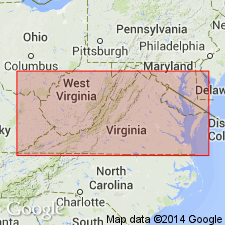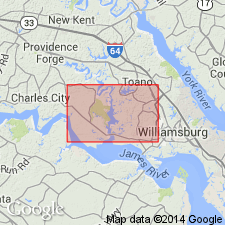
- Usage in publication:
-
- Sedley formation
- Modifications:
-
- Named
- Dominant lithology:
-
- Sand
- Silt
- Clay
- AAPG geologic province:
-
- Atlantic Coast basin
Summary:
Sedley Formation here named in eastern VA. Consists of sands, silts, and clays. Younger than Miocene Yorktown, but older than either Sunderland or Wicomico terraces. Underlies Kilby formation (new). New formation names are necessary because names Sunderland and Wicomico are meaningless. Both of these terraces are underlain by the same formation, not two formations as was previously believed. Terrace as used here refers to land form only and does not refer to or imply existence of any deposits genetically related to them. Age given as Pleistocene.
Source: GNU records (USGS DDS-6; Reston GNULEX).

- Usage in publication:
-
- Sedley†
- Modifications:
-
- Abandoned
- AAPG geologic province:
-
- Atlantic Coast basin
Summary:
Sedley Formation of Moore (1956) is composed primarily of weathered and leached Yorktown sediments at both its type and reference sections. For this reason term Sedley is not used in this report and authors recommend that it be dropped from further usage.
Source: GNU records (USGS DDS-6; Reston GNULEX).
For more information, please contact Nancy Stamm, Geologic Names Committee Secretary.
Asterisk (*) indicates published by U.S. Geological Survey authors.
"No current usage" (†) implies that a name has been abandoned or has fallen into disuse. Former usage and, if known, replacement name given in parentheses ( ).
Slash (/) indicates name conflicts with nomenclatural guidelines (CSN, 1933; ACSN, 1961, 1970; NACSN, 1983, 2005, 2021). May be explained within brackets ([ ]).

